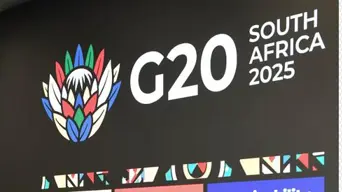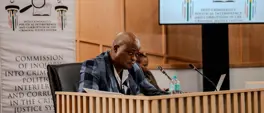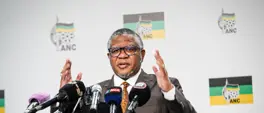PHOSANE MNGQIBISA | When the summit comes to Soweto: Measuring the economic returns of SA's G20 moment
Eyewitness News
19 November 2025 | 17:42Phosane Mngqibisa explains why South Africa's G20 presidency should be viewed as an initial investment toward future growth rather than a sudden windfall.

G20 Summit South Africa, SA. Image: x.com/g20org
Hosting the G20 summit in Soweto, a township emblematic of both struggle and resilience, signifies more than mere diplomatic showmanship.
It marks the first time that the world's leading economic forum gathers on African soil, using the venue to deliberately include grassroots economic players in global value chains. However, behind the symbolism lies a tougher question. Will a week-long meeting of finance ministers and world leaders lead to tangible, lasting economic benefits for South Africa, the surrounding SADC region, and the township economy itself?
The empirical evidence from previous G20 hosts offers useful, if mixed, insights. When China hosted the 2016 summit, land prices in the host city rose by over 22% compared to similar urban centres, driven by venue construction and transport infrastructure improvements that increased the value of commercial real estate. Indonesia's 2022 presidency brought notable localised gains, with hotel occupancy rates surging, foreign exchange earnings increasing, and micro, small, and medium enterprises in host provinces reporting clearrises in order books and sales.
Econometric panel analysis confirmed that the presidency significantly impacted gross regional domestic roduct in several Indonesian provinces, confirming the MICE channel as a true economic multiplier. However, these benefits were primarily focused on host regions and the hospitality sector, with national foreign direct investment and trade flows showing weaker and more uncertain responses.
Long-term economic benefits are mainly generated by policy initiatives and reform platforms initiated during presidencies, rather than by the summit event itself. For instance, the G20 Compact with Africa, launched during Germany's 2017 presidency, led to an average 5% increase in GDP per capita growth among participating countries from 2017 to 2021, according to a synthetic-control analysis by the IMF. This growth was fuelled by higher export volumes, increased FDI inflows, and greater public consumption, all supported by improved macroeconomic frameworks and investment policies. The Compact illustrates that G20 membership and presidencies can act as credible signals, lowering perceived policy risks and reducing the cost of capital for emerging markets committed to structural reforms.
South Africa begins its presidency with clear structural strengths and some restrictions. As the region's economic leader, it is SADC's biggest economy, has the most diversified industrial sector, and is the main trading partner for neighbouring countries. Modelling studies consistently show South Africa as the largest net ‘gainer’ from regional trade liberalisation, obtaining a significant share of GDP and welfare benefits from deeper integration within SADC and the Tripartite. It acts as an investment gateway, foreign capital, especially from BRIC economies, flows through South African subsidiaries to access wider SADC markets. South African growth creates noticeable spillovers for neighbouring economies, strengthening its position as a regional driver.
This central role enables South Africa to exert influence in mediating collective positions on debt relief, climate financing, and technology transfer, thereby enhancing SADC's negotiating power internationally.
The economy continues to face major structural challenges. High unemployment and ongoing income inequality create significant barriers to inclusive growth. Infrastructure gaps, especially in transport, power, and logistics, restrict productive capacity and raise trade costs, which undermine the competitiveness that export-focused strategies and foreign direct investment (FDI) aim to enhance. Skills shortages and limited capacity to absorb new investments also hamper the economy' ability to turn foreign investments into widespread employment and technological gains. Although regional integration appears to be advancing on paper, it is hampered by non-tariff barriers, insufficient liberalisation of services, and institutional differences across SADC countries.
Bottlenecks in the transport system remain a key obstacle; without coordinated infrastructure investments, theanticipated benefits from the African Continental Free Trade Area and regional value chains will not be fully realised.
Choosing Soweto as the summit location reflects a strategic move based on the 'demonstration effect' observed by economists. South Africa's township economy is valued at over 400 billion rand and supports more than two million jobs, but it remains mainly informal, underfunded, and disconnected from formal supply networks. The G20 Business Council's Township Economy Forum and local procurement policies give Soweto SMEs priority access to summit-related contracts, such as catering, logistics, cultural exhibitions, and hospitality. It is expected to generate at least three thousand temporary jobs for Soweto residents during the summit, with ongoing opportunities in event planning and tourism.
The core idea is that international media coverage and proven capability to meet global standards can alter investor perceptions and open pathways to credit, contracts and markets previously inaccessible to township entrepreneurs.
The immediate economic impact is clear. Industry surveys estimate a 2.3 billion rand increase in tourism and services revenue from delegate spending and global media coverage, with hotel occupancy rates in Johannesburg and Gauteng reaching record levels. Infrastructure improvements, including roads, venues, and security systems, drive short-term construction activity and enhance long-term asset values, similar to land-price increases seen in previous host cities.
Expert analysis suggests that sustained investor interest could attract an additional 20 to 40 billion rand in FDI over the next decade, contingent on South Africa's ability to ensure regulatory certainty and implement supportive domestic reforms.
The wider SADC region benefits through various channels. The summit promotes regional integration, cross-border infrastructure, and unified trade and customs procedures as part of the G20 agenda. Key policy goals include removing non-tariff barriers for SADC products and aligning regional policies with AfCFTA protocols to boost market access. Efforts to curb illicit financial flows, which currently amount to roughly 88.6 billion dollars annually draining Africa' resources, are prioritised, impacting SADC's capital development and fiscal space. Additionally, South Africa consolidates SADC nations' positions within the G20 platform, strengthening the region's influence in global talks on debt restructuring, climate finance, and technology transfer.
The summit also reveals geopolitical divides. The US and Argentina have challenged some consensus statements, especially on global health security, climate commitments, and trade disputes. The US boycotted key sessions, which South Africa called "their loss," highlighting the rise of a multipolar world. The decision to include the African Union as a permanent G20 member, achieved under South Africa's presidency, signals a shift toward greater influence for emerging economies.
This change isn't just symbolic; it represents increased agency for the Global South in global economic governance, despite opposition from traditional powers.
The key question is whether South Africa can turn this moment into lasting change. The empirical evidence shows that hosting benefits are conditional; they rely on the host country's capacity to transform summit-driven infrastructure and policy initiatives into fundamental structural reforms.
For example, Indonesia experienced real but localized regional GDP growth; China's land-price increase favoured property owners but did not necessarily lead to widespread productivity improvements. Similarly, the five-percentage-point growth advantage in the Compact with Africa was attained by countries that committed to institutional reforms, rather than just participating in G20 discussions.
For South Africa, the summit serves as a necessary step toward economic renewal, but alone is not enough. The township economy can gain from procurement deals and media coverage, yet true integration into formal value chains requires additional investments in skills development, access to finance, and regulatory reforms. Spillover effects from SADC depend on the region' capacity to establish harmonized trade and customs systems, rather than just declarations from the summit.
The projected 20 to 40 billion rand foreign direct investment will only occur if South Africa resolves regulatory uncertainties, infrastructure issues, and ensures policy consistency at both national and provinciallevels.
The significance of the time horizon cannot be overstated. Past host nations—including China, Indonesia, and Germany's Compact with Africa—have observed that the most meaningful benefits tend to emerge not immediately but over a span of five to thirty years. This delay is due to the time needed for infrastructure projects to develop, for policy reforms to establish credibility, and for investor perceptions to evolve. South Africa's G20 presidency should be viewed as an initial investment toward future growth rather than a sudden windfall. It provides options by expanding policy opportunities, reducing information costs for foreign investors, and serving as a platform for regional cooperation.
Ultimately, whether these opportunities lead to substantial progress hinges on effective domestic governance, cohesive regional integration, and the willingness to maintainreform efforts well beyond the conclusion of the summit.
Ultimately, the Soweto summit bets that combining visibility with credible reform commitments can alter economic paths. Empirical data indicate this is a realistic bet, previous hosts have achieved real benefits, and G20-related policies have produced tangible growth results. However, the evidence also warns against equating symbolic successes with deep structural change. The summit acts as a catalyst, not a solution. Its true value depends on the strength of the economic institutions and policies South Africa and its SADC partners develop in the years ahead, rather than just the number of heads of state present.
Trending News
More in Opinion

19 November 2025 17:33
CHARLES MATSEKE | Ramaphosa at the end of the road: Inside the coming ANC mutiny and SA's pre-2029 realignment

19 November 2025 10:53
CAMAGWINI MAVOVANA | The shutdown is not a protest - It is self-defence

18 November 2025 11:26
THANDO NGENO | Over One million sign petition as 21 November shutdown calls attention to femicide













